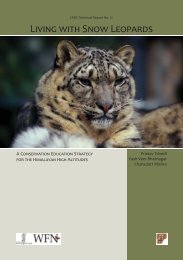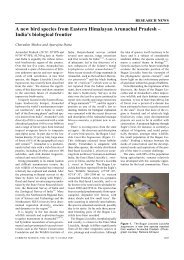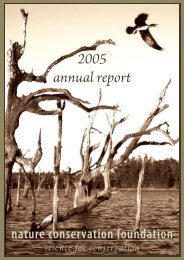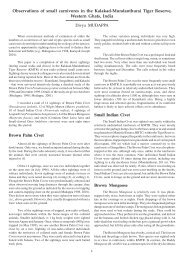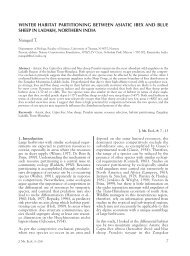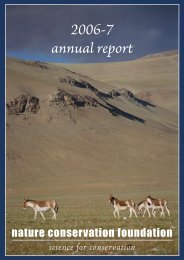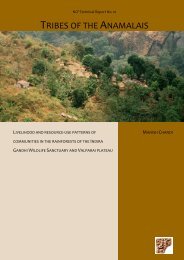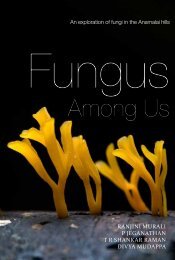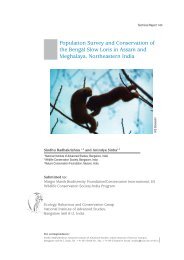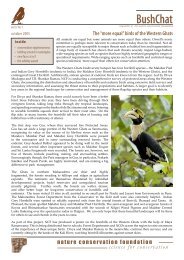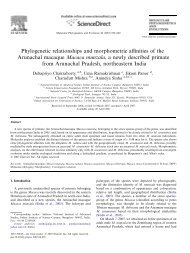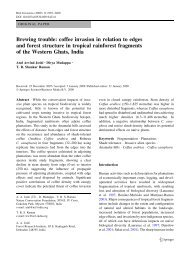towards project snow leopard - Nature Conservation Foundation
towards project snow leopard - Nature Conservation Foundation
towards project snow leopard - Nature Conservation Foundation
Create successful ePaper yourself
Turn your PDF publications into a flip-book with our unique Google optimized e-Paper software.
Towards Project Snow Leopard • 37<br />
<strong>snow</strong> <strong>leopard</strong> and associated species in the Indian Trans-Himalaya by WII. He informed that since<br />
1985 WII has been involved in research on these species in the form of ten completed <strong>project</strong>s,<br />
and one ongoing <strong>project</strong>. These <strong>project</strong>s focused on studying ecology of specific species, surveys,<br />
rangeland ecology and conservation. Initiatives such as SLIMS (Snow Leopard Information and<br />
Management Systems) and conservation education workshops for teachers in Ladakh were also<br />
highlighted. The initiatives were mainly focused in the states of Jammu & Kashmir, Himachal<br />
Pradesh and Uttaranchal.<br />
Dr. Mir M. Mansoor, Chief Wildlife Veterinarian and Biologist, Jammu & Kashmir,<br />
presented a detailed documentation of the illegal trade of <strong>snow</strong> <strong>leopard</strong>s and their body parts<br />
including reported seizures, market values of different parts reportedly sold and legally held products<br />
and body parts of the <strong>snow</strong> <strong>leopard</strong> in the state of Jammu & Kashmir by furriers. As a background<br />
he also provided an overview of the conservation status and national as well as international treaties<br />
and conventions and their signatories relevant to <strong>snow</strong> <strong>leopard</strong> conservation.<br />
Technical Session III<br />
In this session, the first presentation was made by Dr. V. B. Mathur, Dean Faculty of Wildlife<br />
Science, WII and Ms. Shivani Chandola, Research Fellow. The presentation focused on conservation<br />
education products developed by WII in collaboration with Centre for Environment Education,<br />
ISLT and Snow Leopard Conservancy and the teacher training workshops conducted for using<br />
these tools to enhance awareness about <strong>snow</strong> <strong>leopard</strong> conservation. A series of four posters titled<br />
‘Hardy mountains, fragile ecosystems’ and a booklet were developed and used for six teacher training<br />
workshops in Kargil and Leh Districts of Ladakh. The evaluation of these workshops in the form<br />
of formative feedback was discussed and the positive influence of the workshops for teachers was<br />
highlighted.<br />
Dr. Yash Veer Bhatnagar, Senior Scientist NCF and Associate Director ISLT India<br />
Programme, summarized the outcomes of all state-level consultations held in the five range states<br />
during the preparatory process for the national workshop. He outlined the process as consisting<br />
of identification of regions in the respective states for PSL implementation (i.e. areas of known<br />
and potential occurrence of <strong>snow</strong> <strong>leopard</strong>), listing of threats and constraints and suggestions for<br />
a conservation strategy for <strong>snow</strong> <strong>leopard</strong>. A list of threats identified by the Forest and Wildlife<br />
Departments of the respective states and major constraints under the heads of manpower, funds,<br />
capacity, jurisdictions, etc. were also outlined. The expectations of the states from PSL, and the<br />
strategy elements they would like to see in PSL, were also reported.<br />
Dr. Devendra Pandey, Director, Forest Survey of India, presented the scenario of forest<br />
cover in all the five <strong>snow</strong> <strong>leopard</strong> range states of India. He indicated that the percent forest cover was<br />
the highest in Arunachal Pradesh and the lowest in Jammu & Kashmir with the other three range<br />
states having intermediate forest cover. However, the areas above 3,000 m were to be considered a<br />
unique habitat due to their physical, climatic and other features and unsuitable for developing tree



